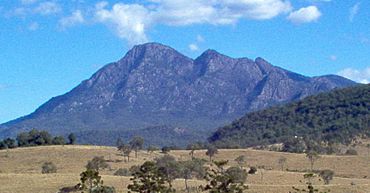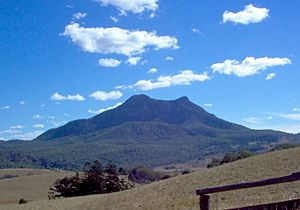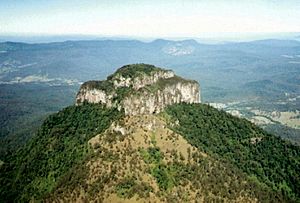Mount Barney National Park facts for kids
Quick facts for kids Mount Barney National ParkQueensland |
|
|---|---|
|
IUCN Category II (National Park)
|
|

Mount Barney
|
|
| Nearest town or city | Rathdowney |
| Established | 6 September 1947 |
| Area | 130.0 km² |
| Managing authorities | Queensland Parks and Wildlife Service |
| Website | Mount Barney National Park |
| See also | Protected areas of Queensland |
Mount Barney National Park is a national park in Queensland, Australia. It is located about 90 kilometers (56 miles) southwest of Brisbane. In 1980, it joined with the nearby Mount Lindesay National Park.
This park is part of a special area called the Scenic Rim Important Bird Area. This means it's very important for protecting several types of threatened birds.
Contents
Discover Mount Barney National Park
Mount Barney National Park is home to tall mountains like Mount Barney, Mount Maroon, Mount May, and Mount Lindesay. These mountains stand proudly above the farms nearby, right on the border between Queensland and New South Wales.
These rugged peaks are what's left of a very old volcano called the Focal Peak Shield Volcano. It erupted about 24 million years ago! Mount Barney is 1,359 meters (4,459 feet) tall. It is the second-highest peak in southeast Queensland. You can find some very rare and unique plants here.
The closest town to the park is Rathdowney, about 15 kilometers (9.3 miles) northeast. This amazing park became part of the World Heritage Gondwana Rainforests of Australia in 1994.
The Peaks of Mount Barney
The park is mostly known for the impressive twin peaks of Mount Barney. Around these peaks, you'll find many other mountains, deep valleys, caves, and cool rock pools. Much of the park is covered in woodland forest.
Other important peaks in the park include Mount Ballow, Mount Ernest, Mount Maroon, and Mount May.
Camping and Staying in the Park
If you love camping, you can go bush camping at Mount May and Mount Barney. Bush camping means you camp in undeveloped areas. There might be some rules about camping during busy holiday times.
Plants and Animals
The park has many different types of plants. Around the bottom of the mountains, you'll see open forests. Higher up, above 600 meters (2,000 feet), there's subtropical rainforest. Near the tops of the peaks, you'll find montane heath shrublands. On the very top of Mount Ballow, there's cool temperate rainforest. On Mount Maroon, there are mallee eucalypt shrublands.
Rare Plants of the Park
Many rare and unusual plant species grow in Mount Barney National Park. These include the endangered Maroon wattle. You can also find the rare mallee eucalypt Eucalyptus codonocarpa. Other special plants are the Mount Barney bush pea and the Hillgrove spotted gum.
Wildlife and Birds
Visitors to the park will often hear many different birds singing. Their bird songs fill the air. You might even spot some playful platypus in the park's waterways.
The rainforest on Mount Barney is a very important habitat for a special type of marbled frogmouth bird. This bird is called the plumiferus subspecies. It is listed as a vulnerable species, meaning it needs protection.
Fun Activities and Hiking
From the top of Mount Barney, you can see amazing views of the Border Ranges and Scenic Rim forests. Mount Barney has been a popular bushwalking spot for a long time. There are more than 30 different paths to reach the East and West peaks.
Hiking Mount Barney
Most of the paths are not looked after by the government. This means you need good navigation skills, especially if it's your first time visiting. Some of the most challenging paths up Mount Barney are Logan's Ridge and Short Leaning Ridge.
For climbers with less experience, Peasants or South Ridge is a better choice. You should plan to spend between eight and ten hours for the climb up and down. The time needed depends on the path and how fit you are. Hikers need to be good at navigating and have strong physical fitness.
It's common to see climbers on the mountain at all times of the day and night. However, you should know the area well before trying to climb at night.
Alternative Hiking Routes
A popular way to hike Mount Barney is to go up via South East Ridge and come down via South Ridge. For this route, you will need navigation tools or someone who knows the area well. The good thing about going up South East Ridge is that it includes the East Peak. From the East Peak, the path goes down into a flat area at the bottom of the West Peak. You can add the West Peak to your walk, which takes about two extra hours for 2 kilometers (1.2 miles).
There are also some easier walks (Class 4) around the base of the mountain. These don't require as much navigation over tough ground.
Rock Climbing and History
Nearby Mount Maroon is a popular spot for rockclimbing. The first European to climb to the top of Mount Barney was Captain Patrick Logan in 1828. He used one of the hardest and most impressive ridges, which is now named after him. Allan Cunningham and Charles Fraser were with him, but they did not reach the summit.
Images for kids
See also
 In Spanish: Parque nacional Monte Barney para niños
In Spanish: Parque nacional Monte Barney para niños







